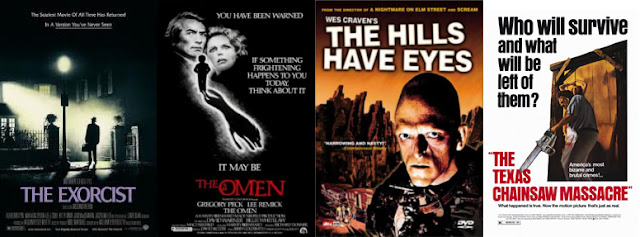Definition of 'Horror':
1. intense fear: a very strong feeling of fear, shock, or disgust. |
2. intense dislike: a feeling of distress or distaste. |
3. something causing horror: something that causes a very strong feeling of fear, shock, or disgust. |
4. something unpleasant: a very unpleasant or unsightly thing. http://encarta.msn.com/dictionary_1861618773/horror.html 1930's–1940's It was the early 1930's when horror films became much more popular, mostly due to the American film producers especially Universal pictures. This decade brought to the screens a series of gothic type films, the most succesful features were 'Dracula (1931)' and 'Frankenstein (1931)'. Some of Frankenstein's scene were very controversial and in one scene where the monster throws a little girl into the lake and accidently drowns her was cut by sensorship boards in Pennsylvania, New York. The film 'Dracula' was reissued after the Production code was inforced in 1934, The Motion Picture Production Code was the industry censorship guidelines that governed the production of films during 1930 to 1968. At least two of the scenes in Dracula had been known too have been cencored as it would have supposedly given the audience horrible nightmares. 1950's - 1960's Advances in technologies occured in the 1950's and the gothic tone changed to films that were a little bit more relevent to the late - century audience. Horror films then seemed to fall into two categories of genre which were horror of armageddon and the horror of the demonic films. In the early 1960's the British company 'Hammer Film Productions' created a series of horror films these were 'The Curse of Frankenstein (1957)', 'Dracula (1958)', and 'The Mummy (1959)' and many sequels. They recieved huge international success from their bloody technicolour films and Terence Fisher the director was acknowledged as pioneer of the modern horror movie. |
Ghosts and Monsters still remained popular but then an essense of the supernatural began to make its way into films with aspects of demonic horror, examples of this was 'The Haunting (1963)' and 'Rosemary's Baby (1968)'.
One of the most ifluential films of the late 1960's was 'Night of the living dead (1968)' the film grossed $30 million and was about zombies, it blended psychological insights with gore and moved away from the gothic trend and brought horror into everyday life.
1970's – 1980's
With the success of 'Rosemary's Baby' it lead to a release of more films with occult themes such as 'The Exorcist (1973)' and 'The Omen (1976)'. The ideas of the 1960's began to influence horror films with the release of 'The Hills Have Eyes (1977)' directed by Wes Craven and 'The Texas Chain Saw Massacre (1974)' directed by Tobe Hooper. Also films were starting to explore fears about technology and society and 'Dawn of the Dead (1978)' did this by also re inventing "body horror".
In 1975 Steven Spielberg brought to our screens 'Jaws' and this film kicked off a wave of killer animal series such as 'Orca (1977)' and 'Up to the Debths (1979)'.
Near the end of the 1980's the release of 'Halloween (1978)' and 'Friday the 13th (1980)', these created a sub genre of increasingly voilent slasher films.
With the success of 'Rosemary's Baby' it lead to a release of more films with occult themes such as 'The Exorcist (1973)' and 'The Omen (1976)'. The ideas of the 1960's began to influence horror films with the release of 'The Hills Have Eyes (1977)' directed by Wes Craven and 'The Texas Chain Saw Massacre (1974)' directed by Tobe Hooper. Also films were starting to explore fears about technology and society and 'Dawn of the Dead (1978)' did this by also re inventing "body horror".
In 1975 Steven Spielberg brought to our screens 'Jaws' and this film kicked off a wave of killer animal series such as 'Orca (1977)' and 'Up to the Debths (1979)'.
Near the end of the 1980's the release of 'Halloween (1978)' and 'Friday the 13th (1980)', these created a sub genre of increasingly voilent slasher films.
1990's
The first half of the 90's saw a series of themes from the 80's being re invented, film sequels such as 'Childs play' , 'A nightmare on elm street' , 'Friday the 13th' and 'Halloween'. They are got quite good success at the box office. During this time films such as 'Candyman (1992)' and 'New nightmare 1994' touched upon fictional horror and real-world horror, both mixing the two.
During this time the horror genre wore itself out with the nonstop slasher and gore films and people were losing interest. To re connect with the audience's horror became more self-mockingly and ironic which lead to the successful films 'Scream (1996)' and 'I know what you did last summer (1997)', these re-ignited the dormant slasher film genre.
2000's
The 20th century saw the beginning of the remake's of famous horror films. Examples of this were (The Amityville Horror, 2005), (The Hills Have Eyes, 2006), (Prom Night, 2008) and (The Texas Chainsaw Massacre, 2003).
Franchise films also became apparent in this century, 'Final destination' and 'Freddy v Jason', and have been very popular with horror fans. A large trend on the extreme, graphic violence horror films returned with 'Wrong Turn (2003)', ' Wolf creek (2005)' and 'The last house on the left (2009)' which was a remake.








No comments:
Post a Comment